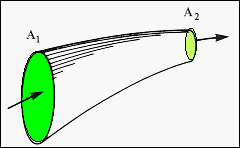|
|||||||||||||||||
|
|
|||||||||||||||||
|
|
|
|||||||||||||||
| Bernoulli's
Equation
The diagram shows a streamtube in a fluid flow that will be assumed to be incompressible, i.e. of constant density. The streamtube is bounded by streamlines and, therefore, fluid particles cannot cross the tube walls. In
considering the flow, matter conservation requires that the mass flow-rate
past any cross-section of the tube be the same. Considering the flow in
steady state, the mass flow-rate through any area A in unit time will be
given by (dm/dt) = ViAir,
where Vi is the fluid velocity and the constant density. For
the two areas, A1 and A2, shown in the diagram this
gives: V1A1r
= V2A2r,
or (V1/V2) = (A2/A1).
|
|||||||||||||||||
 |
|||||||||||||||||
| From:
Wegener,
"What Makes Airplanes Fly?" Springer-Verlag (1991) |
|||||||||||||||||
| If
no external work is done, energy conservation can be applied to the flow.
The change in flow velocity will change the kinetic energy per unit volume,
(rV2/2),
also known as the "dynamic pressure." If the two cross sections are at
different heights, z, in the gravitational field the potential energy per
unit volume, rgz,
will also change. There will also be an internal pressure energy per unit
volume, p, that
will change if the pressure is different in the two locations. Equating
the total energy at locations 1 and 2 then gives:
(rV12/2)
+ (rgz1)
+ p1 = (rV22/2)
+ (rgz2)
+ p2.
Dividing through by r gives:
(rV2/2) + (rgz) + p = Constant = p0 (say) for all locations in the flow. This important result is known as Bernoulli's equation. |
|||||||||||||||||